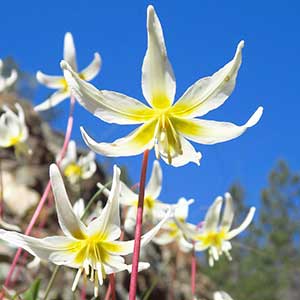Erythronium citrinum
Erythronium propullans
citrus fawn lily, cream fawn lily, lemon color fawn lily, lemon fawn lily, pale fawn-lily
Minnesota dwarf trout-lily, Minnesota fawnlily, Minnesota trout lily
slender, 40–50 mm, sometimes producing sessile offsets.
ovoid, 10–25 mm;
stolon 1 in flowering plants, arising from halfway up stem, 1–3 from bulbs of 1-leaved, nonflowering plants.
9–15 cm;
blade mottled with irregular streaks of brown or white, lanceolate to narrowly ovate, margins ± wavy.
4–13 cm;
blade green, irregularly mottled, elliptic-lanceolate to ovate-lanceolate or elliptic, ± flat, glaucous, margins entire.
12–35 cm.
3.9–12 cm.
1–3-flowered.
1-flowered.
tepals ± white, often pinkish, usually pale yellow at base, lanceolate to narrowly elliptic, 25–45 mm, inner with or without small auricles at base;
stamens 11–17 mm;
filaments linear, white or pinkish, slender, less than 0.8 mm wide;
anthers white, cream, pink, reddish, or brownish red;
style straight, white or pink, 6–10 mm;
stigma unlobed or with lobes shorter than 1 mm.
tepals 4–6, strongly reflexed at anthesis, pale pink to white, darker abaxially, lanceolate, 8–15 mm, auricles absent;
stamens 2–6, 6–8 mm;
filaments white, lanceolate;
anthers yellow;
pollen yellow;
style white, 6–10 mm;
stigma ± unlobed.
obovoid, 2–5 cm.
very rarely produced; when present, may be result of hybridization with Erythronium albidum.
= 24.
Erythronium citrinum
Erythronium propullans
Plants lacking auricles on inner tepals are sometimes segregated as Erythronium howellii, Howell’s fawn-lily, but they do not appear to differ from typical E. citrinum in any other characters. Erythronium citrinum intergrades with E. californicum and E. hendersonii, occasional populations or individuals displaying intermediate or recombined characteristics. Such plants from the upper Scott River drainage in Trinity County, California, which may be the result of introgression with E. hendersonii, have been recognized as variety roderickii.
(Discussion copyrighted by Flora of North America; reprinted with permission.)
Of conservation concern.
Erythronium propullans is known only from Goodhue and Rice counties. It often forms extensive colonies in which flowering plants are sometimes more abundant than nonflowering, 1-leaved ones, and sometimes the reverse. It grows mixed with E. albidum (J. A. Banks 1980), and putative hybrids between them have been reported (T. Morley 1988). Flowers frequently have fewer than six tepals and stamens (C. O. Rosendahl 1919), and may occasionally have only two carpels.
(Discussion copyrighted by Flora of North America; reprinted with permission.)


